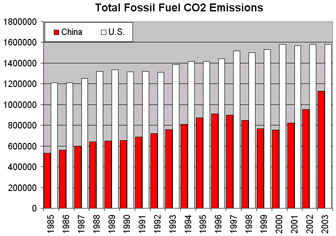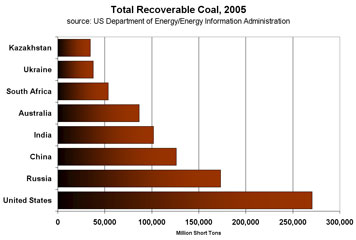China may top U.S. in greenhouse gas emissions in 2007
China may top U.S. in greenhouse gas emissions in 2007
Rhett A. Butler, mongabay.com
March 23, 2007
China’s carbon dioxide emissions may exceed those of the United States in 2007, making the country the world’s largest greenhouse gas polluter, according to analysis of Chinese energy data.
China’s emissions of carbon dioxide are expected to climb by around 9 percent in 2007 to more than 6.2 billion based on projected fuel consumption figures, after jumping roughly the same amount in 2006 and 10 percent in 2005 when emissions stood at 5.3 billion metric tons of the gas. U.S. emissions were 5.9 billion that year.
“It looks likely to me that China will pass the United States this year,” Gregg Marland, a senior staff scientist at the U.S. Carbon Dioxide Information Analysis Center (CDIAC) of the U.S. Department of Energy, told Reuters. “There’s a very high likelihood they’ll pass them in 2007.”
China’s emissions growth is one of the big reasons why the United States and Australia have refused to sign the Kyoto Protocol which calls for emissions limits for industrialized countries but none for developing economies including China, India, and Brazil.
Nevertheless, despite rapid growth, per capita emissions in China are only about one-sixth of per capita emissions in the United States.
China’s emissions are expected to continue growing swiftly in the future due to the country’s heavy reliance on coal, a plentiful resource in the country. However, with rising levels of pollution, the government is keen on developing cleaner coal technologies as well as renewable energy sources like solar, tidal, and biomass. Chinese firms have recently invested billions in biofuel crops and infrastructure in Indonesia and the Amazon.
Scientists say carbon dioxide is an important heat-trapping gas that contributes to global warming. Atmospheric CO2 levels have climbed by more than 35 percent since the beginning of the industrial revolution. Fossil fuel combustion, which releases carbon dioxide into the atmosphere, and land-use change, including deforestation, is blamed for the rise. Roughly 80 percent of anthropogenic carbon dioxide results from fossil fuel burning, while about 20 percent is produced by deforestation.
More news on China’s energy situation

